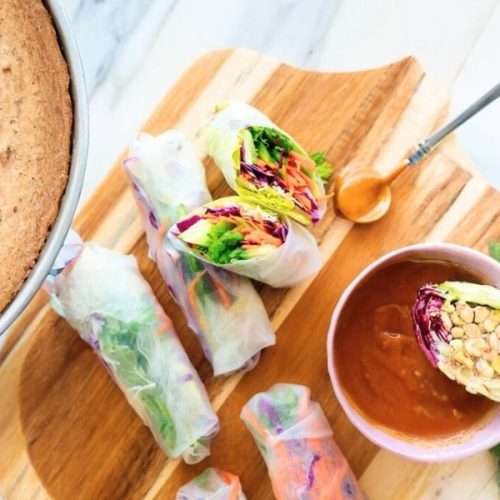Fresh Spring Rolls with Peanut Sauce are a vibrant, light, and nutritious option that stands out for their balance of textures and flavors.
Unlike traditional fried rolls, these are fresh and packed with crunchy vegetables like carrots, cabbage, and cucumbers, offering a fiber-rich, low-calorie base.
The use of rice vermicelli noodles adds plant-based protein and complex carbs, making the dish satisfying yet light.
The creamy peanut sauce contributes healthy fats and rich flavor without excess saturated fat, while herbs like cilantro and mint add antioxidants and a refreshing aroma.
This recipe is not only gluten-free and easily adaptable for vegan or nut-free diets, but also ideal for meal prep—vegetables can be prepped in advance, and assembly takes minutes

Perfect for a quick lunch, party appetizer, or light dinner, these spring rolls combine freshness, health benefits, and ease of preparation into a delightful everyday dish.
Must-Have Tools for Perfect Results
9-inch Round Cake Pan or Pie Pan
Perfect for soaking rice paper sheets evenly without overcrowding. This versatile pan also doubles for baking and roasting tasks in your kitchen.
Julienne Peeler
Essential for creating uniform, thin vegetable strips that roll easily and look professional. Beyond this recipe, it’s great for salads, garnishes, and quick veggie prep.
Lint-Free Tea Towel
Crucial for laying out soaked rice papers, preventing sticking, and keeping rolls intact. It also serves broadly as a multipurpose kitchen cloth for drying and cleaning.
Sharp Chef’s Knife
Enables clean, precise slicing of fresh rolls and vegetables. A quality chef’s knife is indispensable for all chopping, slicing, and dicing tasks.
Small Whisk
Ideal for blending the peanut sauce to creamy perfection. Whisks are invaluable for mixing dressings, sauces, and batters smoothly.

Healthy Veggie Spring Rolls
Equipment
- 1 pot (for boiling noodles)
- 1 9-inch round cake pan or pie pan (for soaking rice papers)
- 1 julienne peeler (for slicing vegetables)
- 1 lint-free tea towel (for drying rice papers)
- 1 sharp chef’s knife (for slicing rolls and veggies)
- 1 small whisk (for mixing peanut sauce)
Ingredients
For the Spring Rolls:
- 2 ounces rice vermicelli or whole grain brown rice noodles
- 1 teaspoon toasted sesame oil
- ¼ teaspoon fine sea salt
- 1 cup torn butter lettuce ribs removed
- 1 cup thinly sliced red cabbage
- 2 medium carrots peeled and cut into matchsticks or thin strips
- 2 Persian mini cucumbers or 1 small cucumber, sliced thinly or julienned
- 2 medium jalapeños seeds and ribs removed, thinly sliced
- ¼ cup thinly sliced green onions
- ¼ cup roughly chopped fresh cilantro
- ¼ cup roughly chopped fresh mint
- 8 sheets rice paper wrappers
For the Peanut Dipping Sauce:
- ⅓ cup creamy peanut butter
- 2 tablespoons rice vinegar
- 2 tablespoons low-sodium tamari or soy sauce
- 2 tablespoons honey or pure maple syrup
- 1 tablespoon toasted sesame oil
- 2 cloves garlic minced or pressed
- 2 to 3 tablespoons water to thin as needed
Instructions
- Prepare the Noodles: Bring a pot of water to a boil. Add the rice vermicelli noodles and cook according to package directions until just tender but still firm (al dente). Drain the noodles and rinse under cold water to stop cooking. Return them to the pot and toss with the toasted sesame oil and sea salt. Set aside.
- Prep Your Vegetables and Herbs: Wash and dry all vegetables thoroughly. Tear the butter lettuce into bite-sized pieces, slice the red cabbage thinly, peel and julienne the carrots, and slice the cucumbers and jalapeños into thin strips. In a small bowl, combine the green onions, cilantro, and mint. Set all fillings within easy reach for assembly.
- Soften the Rice Paper: Fill a shallow, wide pan (such as a 9-inch cake pan or pie dish) with about an inch of warm water. Dip one rice paper wrapper into the water and let it sit for roughly 20 seconds, until pliable but not overly soft. Remove it carefully and lay it flat on a clean, lint-free tea towel.
- Assemble the Spring Rolls: Place a few pieces of butter lettuce along the lower third of the softened rice paper, leaving about an inch border around the edges. Add a small handful of noodles, followed by some red cabbage, carrot strips, cucumber, jalapeño slices, and a generous sprinkle of the herb mix. Fold the bottom edge of the rice paper up over the fillings, then fold in the sides like a burrito, and roll tightly from bottom to top to enclose the ingredients fully.
- Prepare the Peanut Sauce: In a small bowl, whisk together the peanut butter, rice vinegar, tamari, honey, sesame oil, and minced garlic. Add water one tablespoon at a time until the sauce reaches a creamy, dip-friendly consistency.
- Serve: Plate the spring rolls whole or cut them diagonally with a sharp knife. Serve with the peanut dipping sauce on the side.
Notes
- Noodle Choice: Opt for whole grain brown rice noodles for added fiber and nutrients. If gluten-free is a priority, double-check that both noodles and tamari are certified gluten-free.
- Vegan Option: Replace honey with maple syrup for a fully plant-based sauce.
- Nut-Free Variation: Use almond butter or sunflower seed butter instead of peanut butter if avoiding peanuts.
- Advance Prep: Vegetables can be sliced a few hours or even a day ahead and kept refrigerated in airtight containers. The peanut sauce also keeps well when made ahead. However, assemble the rolls just before serving to keep the rice paper soft and avoid drying out.
- Storage Tips: If you need to store assembled rolls briefly, cover them loosely with a damp, lint-free cloth at room temperature to maintain softness. Avoid refrigeration, which can cause the rice paper to harden.
Chef’s Secrets for Perfect Spring Rolls
Mastering fresh spring rolls is all about balance and technique.
To ensure the rice paper wrappers don’t tear or become overly sticky, be mindful of the soaking time — just enough for pliability, typically around 20 seconds in warm water.
Having all your fillings prepped and ready before you start assembling is key to a smooth workflow.
For added flavor depth, lightly toss the noodles with toasted sesame oil and a pinch of salt right after cooking.
When rolling, tuck the fillings snugly but don’t overfill; this helps the rolls hold together without bursting.
Fresh herbs are essential — don’t skimp on cilantro, mint, and green onion, as they provide vibrant aroma and freshness.
Finally, use a sharp chef’s knife to slice rolls cleanly if serving halved; a dull blade will squash them.
Serving Suggestions That Impress Guests
These spring rolls shine as a light appetizer or a wholesome meal, but their versatility extends beyond the plate.
Pair them with a crisp, chilled white wine or a lightly sparkling beverage for a refreshing contrast.
Consider serving alongside a simple miso soup or a bowl of fresh edamame to complete an Asian-inspired spread.
For a fun twist, offer additional dipping sauces like sweet chili or hoisin to complement the peanut sauce.
Garnish the plate with extra herbs or crushed peanuts for texture and visual appeal. These rolls are also great finger foods at parties or picnics, making them crowd-pleasers that look as good as they taste.
Storage Tips for Freshness and Flavor
To keep your spring rolls fresh, it’s best to assemble them shortly before serving, as the rice paper tends to dry out and harden when stored.
If you need to prepare components in advance, slice your vegetables and herbs and store them separately in airtight containers in the refrigerator for up to 24 hours.
The peanut sauce can also be made ahead and refrigerated in a sealed jar for up to a week—just stir before serving.
If you must store assembled rolls, wrap them individually in plastic wrap and place them in a sealed container with a slightly damp paper towel on top to maintain moisture; keep at room temperature and consume within a couple of hours for best texture.
Avoid refrigeration once rolled, as this causes the wrappers to become brittle.
Frequently Asked Questions About Spring Rolls
1. Can I make these spring rolls gluten-free?
Yes! Use gluten-free rice vermicelli noodles and tamari instead of soy sauce to keep the recipe safe for gluten-sensitive diets.
2. What can I substitute for peanut butter if allergic?
Almond butter or sunflower seed butter make excellent nut-free alternatives that maintain the creamy texture and flavor.
3. How far in advance can I prepare spring rolls?
Prepare the veggies and sauce up to a day before, but assemble the rolls just before serving for the freshest texture.
4. Why are my rice paper wrappers sticking together?
Ensure the wrappers are only soaked briefly until just pliable and dry each on a lint-free towel before filling. Over-soaking makes them sticky.
5. Can I freeze fresh spring rolls?
Freezing is not recommended because the rice paper and fresh vegetables lose their texture and become soggy upon thawing.
This recipe has been adapted and simplified from the original version by cookieandkate. We’ve refined the steps for a smoother cooking experience and added helpful notes, nutrition insights, and essential kitchen tools to make it even easier for home cooks.
